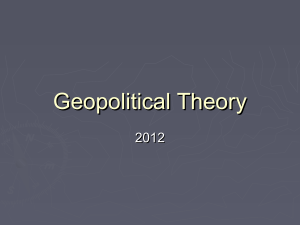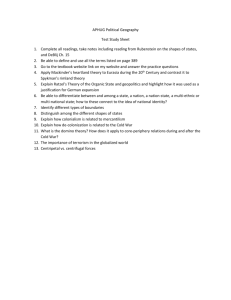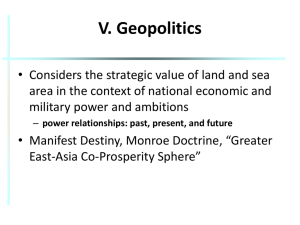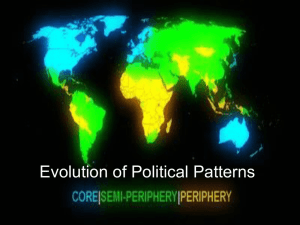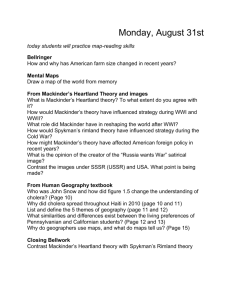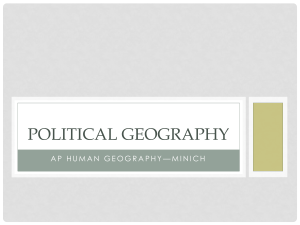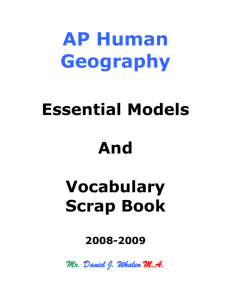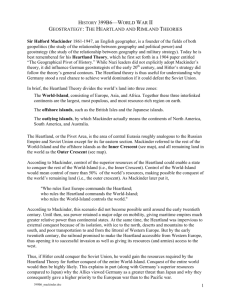Political Models - Mrs. Watson`s Class
advertisement
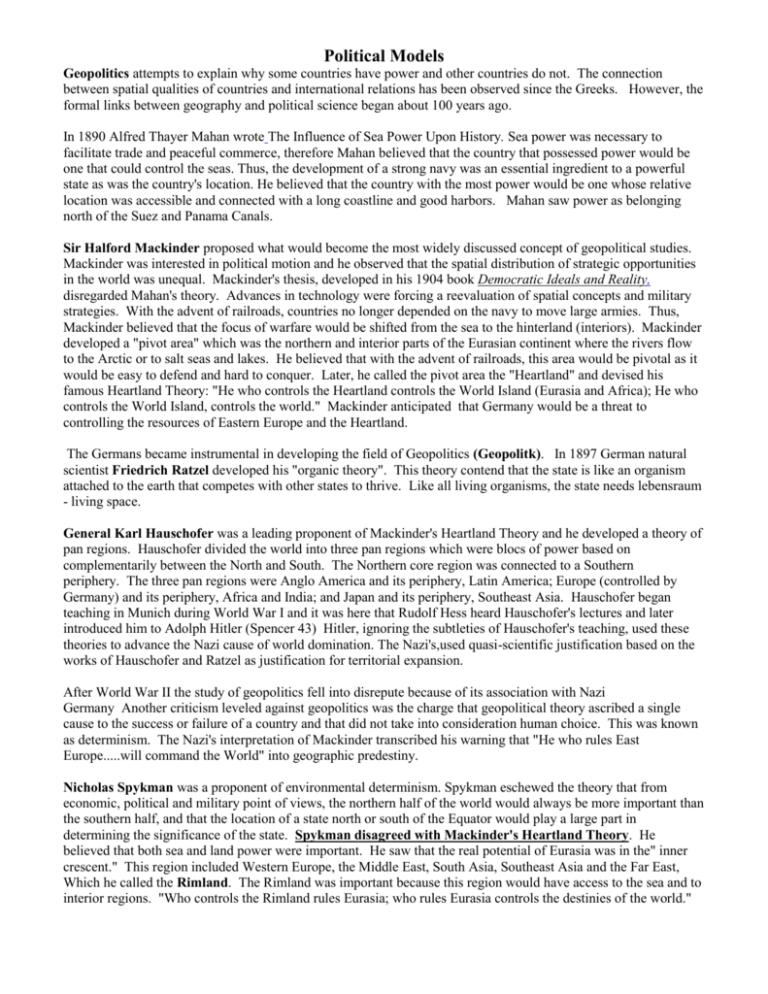
Political Models Geopolitics attempts to explain why some countries have power and other countries do not. The connection between spatial qualities of countries and international relations has been observed since the Greeks. However, the formal links between geography and political science began about 100 years ago. In 1890 Alfred Thayer Mahan wrote The Influence of Sea Power Upon History. Sea power was necessary to facilitate trade and peaceful commerce, therefore Mahan believed that the country that possessed power would be one that could control the seas. Thus, the development of a strong navy was an essential ingredient to a powerful state as was the country's location. He believed that the country with the most power would be one whose relative location was accessible and connected with a long coastline and good harbors. Mahan saw power as belonging north of the Suez and Panama Canals. Sir Halford Mackinder proposed what would become the most widely discussed concept of geopolitical studies. Mackinder was interested in political motion and he observed that the spatial distribution of strategic opportunities in the world was unequal. Mackinder's thesis, developed in his 1904 book Democratic Ideals and Reality, disregarded Mahan's theory. Advances in technology were forcing a reevaluation of spatial concepts and military strategies. With the advent of railroads, countries no longer depended on the navy to move large armies. Thus, Mackinder believed that the focus of warfare would be shifted from the sea to the hinterland (interiors). Mackinder developed a "pivot area" which was the northern and interior parts of the Eurasian continent where the rivers flow to the Arctic or to salt seas and lakes. He believed that with the advent of railroads, this area would be pivotal as it would be easy to defend and hard to conquer. Later, he called the pivot area the "Heartland" and devised his famous Heartland Theory: "He who controls the Heartland controls the World Island (Eurasia and Africa); He who controls the World Island, controls the world." Mackinder anticipated that Germany would be a threat to controlling the resources of Eastern Europe and the Heartland. The Germans became instrumental in developing the field of Geopolitics (Geopolitk). In 1897 German natural scientist Friedrich Ratzel developed his "organic theory". This theory contend that the state is like an organism attached to the earth that competes with other states to thrive. Like all living organisms, the state needs lebensraum - living space. General Karl Hauschofer was a leading proponent of Mackinder's Heartland Theory and he developed a theory of pan regions. Hauschofer divided the world into three pan regions which were blocs of power based on complementarily between the North and South. The Northern core region was connected to a Southern periphery. The three pan regions were Anglo America and its periphery, Latin America; Europe (controlled by Germany) and its periphery, Africa and India; and Japan and its periphery, Southeast Asia. Hauschofer began teaching in Munich during World War I and it was here that Rudolf Hess heard Hauschofer's lectures and later introduced him to Adolph Hitler (Spencer 43) Hitler, ignoring the subtleties of Hauschofer's teaching, used these theories to advance the Nazi cause of world domination. The Nazi's,used quasi-scientific justification based on the works of Hauschofer and Ratzel as justification for territorial expansion. After World War II the study of geopolitics fell into disrepute because of its association with Nazi Germany Another criticism leveled against geopolitics was the charge that geopolitical theory ascribed a single cause to the success or failure of a country and that did not take into consideration human choice. This was known as determinism. The Nazi's interpretation of Mackinder transcribed his warning that "He who rules East Europe.....will command the World" into geographic predestiny. Nicholas Spykman was a proponent of environmental determinism. Spykman eschewed the theory that from economic, political and military point of views, the northern half of the world would always be more important than the southern half, and that the location of a state north or south of the Equator would play a large part in determining the significance of the state. Spykman disagreed with Mackinder's Heartland Theory. He believed that both sea and land power were important. He saw that the real potential of Eurasia was in the" inner crescent." This region included Western Europe, the Middle East, South Asia, Southeast Asia and the Far East, Which he called the Rimland. The Rimland was important because this region would have access to the sea and to interior regions. "Who controls the Rimland rules Eurasia; who rules Eurasia controls the destinies of the world." Political Models Cold War policy makers used the Rimland theory as justification for the policy of containment -stopping the spread the communism. In America, geopolitics was simplified and distorted to serve political ends. Geopoliticans came from international relations and history or from the military but not from the field of geography. For these geopoliticans geography meant distance, size, shape, and physical features that were all static. The idea of geography as spatial patterns and relations that reflect dynamic physical and human processes was absent. The world was seen as being composed of two blocs with no overlapping areas. A.P de Seversky saw that the development of air power made land battles obsolete. Thus, he concluded that whoever controls the skies would be the world power. At the time of his writing, the U.S. and the U.S.S.R. were the two most important air powers. He used an azimuthal equidistant projection centered on the North Pole to show the air dominance of the U.S. and the U.S.S.R. On this map there was an area of intersection he called the "area of decision". He believed that whoever controlled this area would be dominant. Immanuel Wallerstein writing in the 1970s, developed his World System theory. A world system is a social system, one that has boundaries, structures, member groups, rules of legitimization, and coherence. According to Wallerstein, there are two varieties of World-system: World empires in which there is a single political system over most of the area; and those systems in which such a single political system does not exist over all of the space. The term used to describe this type of world system is "World-economy." Wallerstein believes that the World-economy was developed in Europe during the 16th century and was made possible by a division of labor that was not merely functional, but also geographical. Within this world-system are three geographic areas. Core states are advanced areas of the World-economy. They have strong state structures and a national culture, and its peoples are integrated. Core states are economic powers connected by trade and technology, and they are exploiters of the periphery. Peripheral areas are weak states; either colonial states or states with a low degree of autonomy. The third region is comprised of the semipheriperal areas; those that act as a buffer between the core and the periphery. Wallerstein's World System also reflects determinism as he believed that since the Worldsystem had been fully developed by the 1950's, no country would be able to enter the system and be able to successfully compete and that those countries in the periphery would probably never be able to catch up economically to the core countries. Today geographers now view the world in terms of spatial patterns that are not containable within national boundaries. They see the world as an interdependent system and the nation-state as part of a world that is a shared area. A proponent of this theory is Saul Cohen, who wrote Geography and Politics in a World Divided. Cohen divides the world into geostrategic regions. The two main regions are the Maritime, which is dependent on trade, and in the Eurasian Continental Realm, which is interior in direction. Within each realm are first -order states (the ones that are the most powerful within the region). His model shows Japan, the U.S. and the European Community as the current first -order states for the maritime realm and China and the Soviet Union as the first -order countries for the continental realm (Demko and Wood 40). In his model shatterbelt states separate the realms or regions with the realms. There are also independent states such as Pakistan, India, Thailand, and Vietnam. Gateway states lie between realms and regions and act as linkages. Asymmetrical states are in a region but they behave differently than the others. Cohen, unlike Wallerstein, believes that power is in a lot of different places and is continually changing in an integrated system. Throughout the study of geopolitics, the Middle East has always been a region of strategic importance as it connects Eurasia and Africa. Whether part of Mackinder's World Island or Spykman's Rimland, the Middle East has always been seen as a region of strategic importance. In Cohen's model, the Middle East is a shatterbelt where the maritime realm meets the continental realm. Once a powerful region of great empires and an important trade region, the Middle East found itself susceptible to foreign influence in the form of colonial domination and as a pawn in an international chess game between the Soviet Union and the United States. The tricontinental position of the Middle East will always be important geographically . It is unclear if the Middle East will be able to overcome its economic and social difficulties to be able to reestablish itself as an important region of trade and culture or if it will continue to be a shatterbelt caught between colliding external cultural and political forces.
